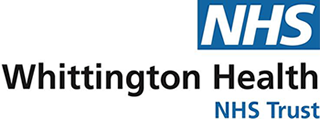Lower Limb Pain
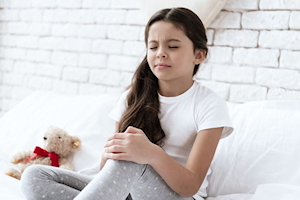 Common Lower Limb Pain in Children and Young People
Common Lower Limb Pain in Children and Young People
Lower limb musculoskeletal pain is a common issue among children and adolescents, often arising due to rapid growth, sports injuries, or developmental conditions. Often the pain is self-limiting and can improve through activity modification, stretches and strengthening.
Knee pain
Osgood-Schlatter Disease
Management strategies:
Anterior knee pain
Management strategies:
A condition often seen in active adolescents, characterised by pain and sometimes swelling just below the knee, where the patellar tendon attaches to the shinbone (tibia) around the growth plate. It is caused by repetitive impact from activities like running and jumping. Pain is sometimes felt during activity but more often is felt after finishing the activity.
- Reduce sports participation temporarily if experiencing high levels of pain.
- Ice knee daily- wrap ice pack in a towel and ice knee for 15mins 2-3 times a day.
- Stretch muscles on front and back of knee- quadriceps and hamstrings. See knee stretches further down on this page.
- Once pain has reduced gradual strengthening of the muscles around the knee helps to support proper function. See knee strengthening exercises further down on this page.
- Graded return to sport once pain has settled.
Please see this leaflet created by the Association of Paediatric Chartered Physiotherapists for more information: APCP: Osgood Schlatter's Disease
Pain felt in the front of the knee. Often felt around the knee cap (patella).Often referred to as "runner's knee," Pain is most commonly due to imbalances in the muscles around the knee, or repetitive strain in a sporty child.
- Reduce sports participation temporarily if experiencing high levels of pain.
- Stretch muscles on front and back of knee- quadriceps and hamstrings. See knee stretches further down on this page.
- Strengthening of the muscles around the knee and hip helps to support proper function. See knee strengthening exercises further down on this page.
- Graded return to sport once pain has settled.
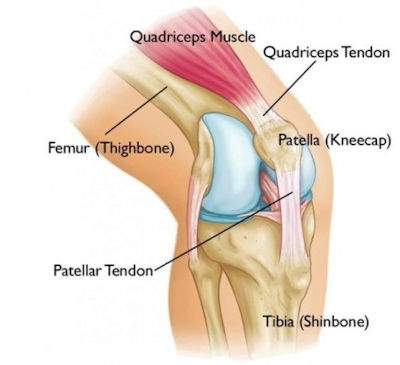
Heel Pain
Sever’s Disease
Management strategies:
A common cause of heel pain in growing children, particularly those involved in sports. It occurs when the growth plate in the heel becomes irritated due to repetitive stress or tight calf muscles.
- Reduce sports participation temporarily if experiencing high levels of pain.
- Ice heel daily- wrap ice pack in a towel and ice heel for 15mins 2-3 times a day.
- Wearing supportive footwear eg trainers. Avoiding flat shoes such as canvas shoes, ballet pumps.
- Using a gel heel cup in shoes if experiencing high pain levels to offload heel.
- Stretching calf muscles- see calf stretches further down on this page.
- Once pain has reduced gradual strengthening of the muscles around the foot and ankle helps to support proper function. See foot and ankle strengthening exercises further down on this page.
- Graded return to sport once pain has settled.
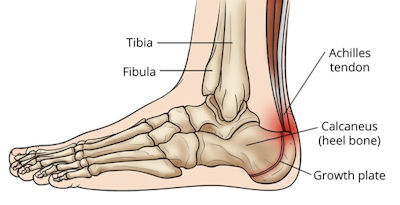
Please see this leaflet created by the Association of Paediatric Chartered Physiotherapists for more information: APCP: Sever's Disease
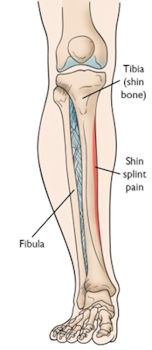
Shin pain
Shin Splints (Medial Tibial Stress Syndrome)
Pain along the inner edge of the shinbone (tibia) that is common in children who participate in running or jumping activities. It is caused by overuse or improper training techniques and often tight calf muscles.
Management strategies:
- Reduce sports participation temporarily if experiencing high levels of pain.
- Ice shin daily- wrap ice pack in a towel and ice heel for 15mins 2-3 times a day.
- Wearing supportive footwear eg trainers. Avoiding flat shoes such as canvas shoes, ballet pumps.
- Stretching calf muscles- see calf stretches further down on this page.
- Once pain has reduced gradual strengthening of the muscles around the foot and ankle helps to support proper function. See foot and ankle strengthening exercises further down on this page.
- Graded return to sport once pain has settled.
Growing Pains
Growing pains are non-specific pain typically experienced in the legs, often in the evening or at night. . Growing pains are common in children aged 3-12 years. It's harmless and usually gets better on its own. The symptoms of growing pains can come and go over months, even years.
- an aching or throbbing in both legs
- in the muscles, not the joints
- in the evening or night-time (and goes away by morning)
- The pain can be treated with painkillers like calpol or paracetamol (please consult your pharmacist or healthcare professional)
- Using a heat pack or hot water bottle if the area is not red/hot/swollen
When to Seek Professional Help
Please speak to your GP about a referral to paediatric physiotherapy if
- Your child experiences persistent lower limb pain, difficulty walking or participating in activities, or if the pain affects their daily life.
- Your child experiences any swelling
- Your child has a new onset of lower limb pain following an injury
- Your child is limping or you have noticed a change in their gait – Link to limping child page (concerns about leg shape and walking)
Lower Limb Exercises
Knee stretches
Seated Hamstring Stretch
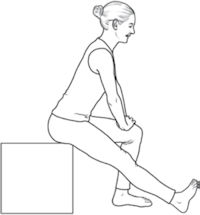
- Sit upright on the edge of a seat.
- Place the leg to be stretched out in front of you.
- Keep your knee, and your back straight.
- Point toes towards the sky.
- Lean forwards until you feel a stretch down the back of your thigh.
- Hold this position for 2x 30 seconds on each leg.
- Complete 3x daily
Quadriceps stretch
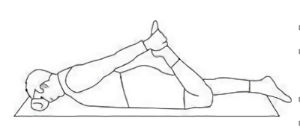
- Lie on your front with your legs together and your head resting on a pillow or your hand.
- Gently bend your knee until you feel a stretch in the front of your thigh, use your hand to assist the movement.
- Hold this position for 2 x 30 seconds on each leg.
- Complete 3x daily
Hip Stretches
Hip Flexor stretch
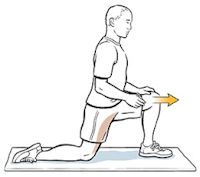
- Start in a kneeling position
- Place one foot on the floor out in front of you whilst staying on the knee of the other leg.
- Tuck your bottom in.
- Keep your back upright and chest out, push your hips forward by bending your front knee.
- Make sure that you keep your hips in position and do not let your lower back arch.
- Hold this position for 30 seconds on each leg
- Complete 3x daily
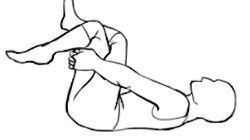
Gluteal stretch in lying
- Lie on your back and bend both knees up, keeping your feet on the floor
- Cross your one leg over the other leg, so that the outside of your ankle is resting on your knee.
- Pull your uncrossed leg towards leg your chest.
- Use your hands to pull the leg further in towards you.
- You should feel the stretch in buttock. Hold this position for 30 seconds on each leg.
- Complete 3x daily
Calf stretches
Calf stretch a) knee extended
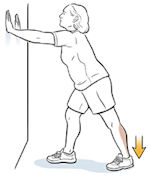
- Stand holding onto a wall in a lunge position with both big toes pointing to the wall
- Straighten back knee with heel flat on floor
- Bend front knee and lunge forwards until a stretch is felt in lower part of the back of leg (calf)
- Hold this position for 30 seconds on each leg.
- Complete 3x daily
Calf stretch b) knee bent
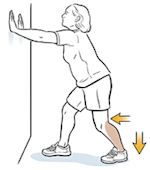
- Stand holding onto a wall in a lunge position with both big toes pointing to the wall
- Bend back knee with heel flat on floor
- Bend front knee and lunge forwards until a stretch is felt in lower part of the back of leg (calf)
- Hold this position for 30 seconds om each leg
- Complete 3x daily
Knee and Hip Strengthening
Straight Leg Raise
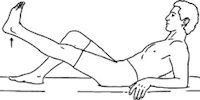
- Lie on your back with your legs bent and feet flat on the floor
- Straighten your affected leg out so that it is flat.
- Tighten your abdominal and thigh muscles, and lift this leg directly up, keeping the knee completely straight.
- Ensure your stationary leg stays still with the knee pointing to the ceiling.
- Control the movement as you lower the leg back down onto the floor.
- Hold 5 seconds, repeat 10x3. 3-4 times a week
Inner range quads
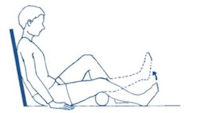
- Start in a half lying position with your legs stretched out in front of you with a towel under your affected knee.
- Keep your toes upwards and extend your knee by tightening your thigh muscles.
- Hold 5seconds, repeat 10x3. 3-4 times a week.
Seated leg extension
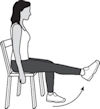
- Sit on a chair.
- Stretch one leg out and keep it in that position for required duration.
- Return your leg to the starting position and then repeat with your other leg.
- Hold 5seconds, repeat 10x3. 3-4 times a week
Wall squats
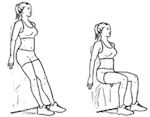
- Lean against a wall, with your feet away from the wall and shoulder width apart.
- Your back and buttocks should remain in contact with the wall throughout.
- Slide down the wall, aiming to reach horizontal with your thighs.
- Your knees should be at 90 degrees at this point.
- Push yourself back up the wall, driving the movement with your buttock muscles.
- Repeat 10x3. 3-4 times a week
Bridging
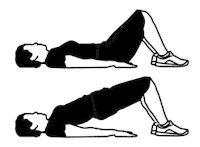
- Lie on your back with your knees bent and your feet flat on the floor.
- Tighten your buttock muscles and lift your hips up into the bridge position, creating a straight line between knees and shoulders.
- Make sure you keep your hips up and level throughout the movement. Engage core and buttocks muscles throughout.
- Hold 5seconds, repeat 10x3. 3-4 times a week
Single leg bridge
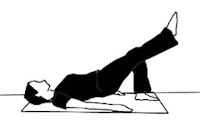
- Lie on your back with your legs hips width apart.
- Bend one leg, keeping your foot on the floor.
- Your knee and foot should be in aligned with hip.
- Tighten your abdominal and buttock muscles and lift your hips up off the floor, allowing your straight leg to lift with the movement.
- Your thighs should remain level.
- Hold 5seconds, repeat 10x3. 3-4 times a week
Hip abduction in side-lying
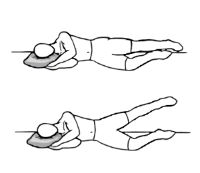
- Lie on your side, making sure there is a straight line from your head, through your trunk, down your legs to your toes.
- Straighten your legs and pull the toes up towards you.
- Raise the top leg straight up, then control the motion back down.
- Ensure your leg goes directly up, as though sliding up and down a wall.
- Control the movement as you lower your hips back to the floor and repeat with the other leg.
- Repeat 10x3. 3-4 times a week
Foot and Ankle Strengthening
Heel raises
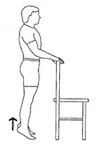
- Hold on to a solid object with your legs hips width apart.
- Keeping your knees straight, rise up on to your toes, and control the movement as you lower back down.
- Hold 5seconds, repeat 10x3. 3-4 times a week
At what point will these exercises start to make a difference?
The above exercises can assist with managing symptoms at home. Most musculoskeletal conditions see improvement within 8-12 weeks.
Last updated10 Sep 2025

